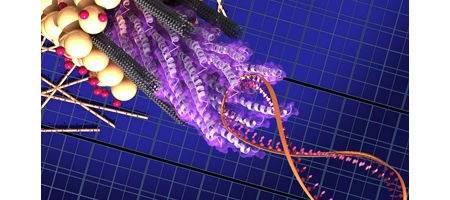Researchers at MIT have enlisted viruses to help assemble solar cells and improve their performance.

While it’s been known that carbon nanotubes can improve the efficiency of electron collection from a solar cell’s surface, there have been two big problems to their use.
First, the manufacture of carbon nanotubes generally produces a mix of two types, some acting as semiconductors and some as metals. The new research shows that the effects of these two types tend to be different, because the semiconducting nanotubes can enhance the performance of solar cells, but the metallic ones have the opposite effect. Nanotubes also tend to clump together, which reduces their effectiveness.
But the MIT team has managed to rope in viruses to do some of the dirty work. They’ve found that a genetically engineered version of a virus called M13, which normally infects bacteria, can be used to control the arrangement of the nanotubes on a surface. It keeps the tubes separate so they can’t short out the circuits, and don’t clump.
The system the researchers tested used a type of solar cell known as dye-sensitized solar cells, but say it could also work with quantum-dot and organic solar cells. In tests, adding the virus-built structures enhanced the power conversion efficiency to 10.6 percent from 8 percent — almost a one-third improvement.
This dramatic improvement takes place even though the viruses and the nanotubes make up only 0.1 percent by weight of the finished cell. With further work, the researchers think they can ramp up the efficiency even further.
Prashant Kamat, a professor of chemistry and biochemistry at Notre Dame University, says that while others have attempted to use carbon nanotubes to improve solar cell efficiency, the improvements observed were marginal.
“It is likely that the virus template assembly has enabled the researchers to establish a better contact between the TiO2 nanoparticles and carbon nanotubes. Such close contact with TiO2 nanoparticles is essential to drive away the photo-generated electrons quickly and transport it efficiently to the collecting electrode surface,” he says
“Dye-sensitized solar cells have already been commercialized in Japan, Korea and Taiwan. If the addition of carbon nanotubes via the virus process can improve their efficiency, the industry is likely to adopt such processes.”
Because the process would just add one simple step to a standard solar-cell manufacturing process, it should be quite easy to adapt existing production facilities and thus should be possible to implement relatively rapidly, the team says.






